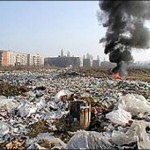Free-radicals
The functioning of the human body is a process of complex chemical interactions which works perfectly as long as these chemicals are in natural balance. We put a strain on, and weaken our bodies with a vast amount of damaging agents. One of these determining agents are free radicals.
Free radicals are continually brought about by factors such as: alcohol consumption, smoking, medicine, drugs, inadequate diet, environmental pollution, air pollution, poisonous chemicals, UV radiation and electro-smog.
Free radicals are molecules or molecule parts that in their outermost crust consist of an odd number of electrons.
Normally bonds don’t split in a way that leaves molecules with unpaired electrons and by the splitting of weak bonds free radicals are formed. They are unstable and intensely try to find other molecules from which they can borrow electrons. In this way free radicals can enter chemical reactions very easily with other compounds.
However, environmental factors such as pollution, radiation, cigarette smoke and herbicides can also create them.
Normally, the body can handle free radicals, but if antioxidants are unavailable, or if the free-radical production becomes excessive, damage can occur. Of particular importance is that free radical damage accumulates with age.
Free radicals are also formed in our environment, for example from the energy exchange of oxygen molecules, through ultraviolet or radioactivity or from the effect of heat exchange and through chemical reactions. Environmental factors such as pollution, radiation, cigarette smoke and herbicides can also create them. The free radicals in our environment effect our bodies’ biochemical processes when we consume foods, breathe air and through our skin.
Our bodies’ self protection mechanism has a pretty high tolerance in keeping free radicals in check and can prevent them from starting a damaging chain-reaction. The free radicals that get by our immune system can have damage on our bio-molecules and thus cause sickness and disease for example cardiovascular change, tumor and cancer growth.
Free radicals first attack the amino acids that make up fat molecules because their double bonds are very sensitive to oxidation damage.
The second step namely propagation is a much more intense process because the freely formed free radicals (superoxide and hydroxide) react with unfilled fat cells and creates more free radicals.
The process ends with the generation of non-radical substances for example aldehydes.
They can also change the molecular structure of foods making them damaging to health. The most well know n of these reactions is oxidation and the spoiling of food that comes with change in color, smell and taste. Alde hides and ketons for example are responsible for bad the bad taste of food. Oxidation on the other hand doesn’t only change the structure of fat cells but also damages other molecules such as vitamins and proteins that make up amino acids. This makes the nutritional value of food much less than normal.
Some free radicals arise normally in our bodies. Sometimes our immune system’s cells create them on purpose in order to neutralize viruses and bacteria.
In some free radical and lipid oxidation processes our body brings about chemical reactions that are essential to keeping its balance (for example substances that control blood pressure, gore and hormones). If free radicals are created by the body naturally it has the ability to neutralize them.
In the case that something disrupts our inner free radical production (smoking, medication, strong UV radiation, inadequate or unbalanced diet!) and too many radicals are produced, our self protection mechanism is not enough to balance itself out. When this happens the molecules needed for survival change in structure and this disrupts our biochemical balance leading to sickness and disease. In our day medical science has observed a number of diseases and an escalation of symptoms that attest to the presence of free radical processes. Of these diseases the most widespread are Free radical damage within cells has been linked to a range of disorders including cancer, arthritis, atherosclerosis, Alzheimer’s disease, and diabetes.
These include in particular cardiovascular diseases, for example of atherosclerosis, cancer diseases, eye, joint and neurological abnormalities, premature skin aging and the senility of old age can be mentioned.
Research proves that antioxidants tie down free radicals and thus are able to prevent serious disorders, even ones that lead to death. Researcher Dr. Richard Cutler stated that a human life’s length is in direct proportion to the amount of antioxidants in the body.
sources: www.belorvos.hu, www.fogyjonvelem.hu, www.rtlhirek.hu, http://myreille.hu






